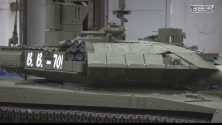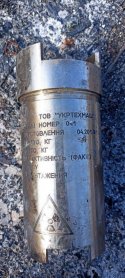You are using an out of date browser. It may not display this or other websites correctly.
You should upgrade or use an alternative browser.
You should upgrade or use an alternative browser.
Russian Military News, Reports, Data, etc.
- Thread starter tphuang
- Start date
Afaik most Russian platforms cannot be integrated directly with Chinese satellite guidence, but Belarusian Polonez-M missiles can because of their Chinese origin.
Belarus seems to only have 6-16 of these, nevertheless, they have full 290km range, 8 rockets per launcher and 1 min firing time before resuming movement. Meaning essentially PHL16s without the 500km special missiles, making them the most powerful MLRS west of the Urals.
In that way, Belarus could assist Russia with a capability not present in either Russian forces nor regional NATO ones.
Besides, Belarus could by China potentially be seen as a defensive participant, which would make it much easier politically for Beijing to justify military aid towards Belarus than for Russia.
This bit:
This is a solvable/solved problem, should China be inclined. In previous joint exercises an integration layer was created to allow the two systems to talk to each other:Afaik most Russian platforms cannot be integrated directly with Chinese satellite guidence,

It should be possible to get this system out and patch it up and use it in anger.
Apparently Russians involved in joint exercises with PLA say PLA logistic and ISR support tremendously increase the combat potential of their own weapons. It was described as like adding a little bit of MSG to a dish.
This bit:
This is a solvable/solved problem, should China be inclined. In previous joint exercises an integration layer was created to allow the two systems to talk to each other:
View attachment 99120
It should be possible to get this system out and patch it up and use it in anger.
Apparently Russians involved in joint exercises with PLA say PLA logistic and ISR support tremendously increase the combat potential of their own weapons. It was described as like adding a little bit of MSG to a dish.
If you are referring to the exercise in Qingtongxia, very few Russian assets were used though. Only Su-30SM and limited ground assets were Russian. Most of the Russian troops learned to operate Chinese weapons.
He first pointed out that Shahed-136/Geran-2, on account of its small warhead, moderate range and cheap price intended to be used in mass should conceptually thought of as fancy MLRS rounds instead of low grade cruise missile. The reason for the cheapness is partly to do with size and partly because you're using an engine that's only a small step above an RC plane, guidance package that's about as complex as a smart phone's gyroscope and GPS. This results in a weapon that's easy to intercept for air defense but due to their numbers when used in large enough number they can penetrate any air defense.
The downside is the warhead. With only a 50kg warhead it won't be effective against a lot of targets you may want to hit. If you try to scale it up to a 450kg warhead you necessarily need to give it a much more military like and expensive engine, this drives up the cost enough that you have to worry about getting shot down by air defense so it then also need fancy guidance and in the end you'll just end up with a Tomahawk or Kalibr.
One suggestion out of this dilemma he suggests is for Russia to go down the same path as PLA's J-6 UAV. J-6 UAV can pack 2 tons of explosive all together, is much faster than Shahed-136 and is actually not that much more expensive given the air frame is sunk cost and you just need to pay for the conversion kit.
Instead of Mig-19 though he suggest Russia's stockpile of Mig-23 could be used for this. If they can get help from certain companies already experienced in this work such converted drone missiles could be available in a number of month. Their main disadvantage - that of hogging runway time would not be a large drawback in this war given plentiful military airfields in western Russia and the fact that VKS isn't making that many sorties a day.
You could just build more Kalibrs and Kh-101 in the time it takes to fix and "drone-ify" a single MiG-23. They were retired almost 25 years ago.
The only alternative would be buying them from countries who still operate it(if they want to sell it and don't mind the risk of being sanctioned), but still, would probably be money and time better served on just making more cruise missiles.
The only alternative would be buying them from countries who still operate it(if they want to sell it and don't mind the risk of being sanctioned), but still, would probably be money and time better served on just making more cruise missiles.
This statement of 50 units produced per day is still very doubtful. Some sources actually indicate that they are producing between 30 to 50 Kalibr units a day using TRDD engines from stock (in addition to those they produce annually) to increase production of Kalibr missiles, using as evidence the hiring of more factory workers:Not enough and more to come.
They make more calibres in a week than they fire in a month.
I already made a comment along these lines:
The War in the Ukraine
I mean the history/geopolitical lecture is nice but it does not answer my question. I don't think a few of those replies do fully either. The justification of the war is just that, justification, I want to know how Russia can/will end this war now that it has started it 6 months ago with no end...
www.sinodefenceforum.com
With respect to my text above, RUSI disagrees:This western claim that the Russians are running out of missiles is ridiculously funny, especially cruise missiles. For example, according to the Russian MoD bidding website, the production of TRDD-50x turbo-jet engines (Izdelie 37 and modifications) is at the level of 1,500 units per year. Just divide into groups because only Kalibr (3M14) uses TRDD with code 37-01. The others (02, 03, 04, M) are equipping Kh-555, 101 and the new missile 9A5015 (Izdelie 715).
Also, Kalibr (Kalibr-NK), Club, R-500 – they are all different missiles. And each has very significant numbers on the “shopping list” of recent years. Only Kalibr-NK is being produced at a rate of 200-250 units per year. Counting that they have been manufactured since 2014, the account is far from those estimated by the traditional media. And there's still X55, 101/102 etc..
According to the most recent publicly available reports, in the first half of 2017 NPO Novator was able to produce 60 3M-54 Kalibr missiles for the Russian military
But they don't know that this was a quarterly delivery and not a semi-annual one, implying that in 2017, 120 Kalibr missiles were produced, if you put 60 units delivered per semester, the production number is around 240 units, a number within the range I mentioned earlier, between 200-250 units per year.
Probably only Kalibr-NK had a stockpile of between 1,600 and 2,000 units before the start of the war. Also, we have the media reporting an approximate number of older missiles before the war started:
See that this article is from July, this Ukrainian media claims that Russia had already launched something around 3,000 missiles, with an interval without carrying out mass bombings that took place between August and September, the number should now approach around 3,500 missiles launched.In total, the Russian Federation had almost 7,000 medium- and short-range missiles (up to 5,500 km) at the beginning of the war. Almost half of them are low-precision X-22, X-55, “Point-U” complexes.
Russia has already used about 3,000 missiles to attack Ukraine, although it is difficult to say exactly which ones. Most likely, the occupiers have few Kalibr and Iskander missiles left. This was confirmed by the fact that Russia is hitting Ukrainian territory not only with old and cheap missiles, but also with new and expensive ones. For example, it uses P-800 “Onyx” anti-ship missiles, costing more than $1 million per unit.
“If the Russians really run out of Kh-101, Kalibri and long-range missiles of the Iskander complexes, then only the old Kh-55 and Kh-22 with a range of more than 500 km remain. But the bad news is that there are more than 2,000 of these missiles, and they may be enough for several more months of bombing. And their inaccuracy may lead to dire consequences,” state military experts.
It is worth noting that there are Iskander cruise missiles - the Iskander-K(9M728(R-500)/9M729), Russia has 13 Iskander missile brigades each with 48 missiles, this translates into 624 Iskander missiles available in all brigades, I would say that Russia spent 1/3 of all the missiles of all the brigades, that is, a number equivalent to 208 units, the problem is there is also the ballistic version of the Iskander - the Iskander-M, but it was not heavily used compared to Iskander-K. Still on the subject of Iskander, the Iskander-K - 9M728(R-500) has been in service since 2009 when it went into production in the same year, that's more than a decade in production, even if it had a production of 50 units per year. , this would be more than 600 units produced by the end of 2021, a number almost equivalent to the total missiles available in all 13 Iskander brigades, I would say that there is a good amount of Iskander-K reserve if we look at the production of the TRDD -50, not to mention the Iskander-M(ballistic) which has been in service since 2006.
Regarding the production of Iskander, we have this source:
They cite this source:The second company working around the clock is the manufacturer of ballistic missiles for the Iskander, the Yars complex, and the Bulava missile – the Votkinsk Plant. In 2020, it switched to a four-day working week, shedding employees of retirement age and employees of subsidiaries. Now the situation has changed, and it is seeking an additional 500 staff. Obviously, the increase in production is associated with the need to replenish missiles for the Iskander complex. Production has risen to about 60 missiles from about 50 a year earlier.
Here are some indications from Russian sources, but it should also be taken with caution. Annual production:Russian military will receive ten Bulava ICBMs in 2019
The Votkinsk plant is also manufacturing 50 missiles for the Iskander-M technical-operational missile systems.
"As part of the state defense order for 2019, the Votkinsk plant is manufacturing 50 missiles for the Iskander-M operational technical missile systems, 21 mobile and silo-based intercontinental ballistic missiles for the Yars complexes, as well as 10 ballistic missiles. Bulava intercontinental missiles.- said Tolmachev.
Kalibr(3M14/3M54) - between 70 to 290 units
Kh-101/102 - 604 units in 2013 with Shoigu promising to increase production by 5x by the year 2016
P-800 Oniks - less than 200 units
-------------
P-700 Granit - 328 units
P-270 Moskit, P-500 Bazalt, P-1000 Vulkan - less than 1000 total units
S-10 Granat - around 100 units
Prices:
This profile above gave a good image in relation to this and I will exempt myself from doing this, it is worth mentioning here, the same profile said that in 2019 400 Kalibr were produced, which I do not believe, but if I really had a confirmation of this production, the Kalibr number I quoted earlier would go up to something equivalent to 3,500 to 4,000 units.
Even if this news that they are producing 30-50 Kalibr a day is true, they could not sustain this production for long, not without carrying out the full mobilization of the industries. I've seen sources claiming from 120 Kalibr produced per week (17 Kalibr per day) to 30-50 Kalibr produced per day which would equate to 210-350 per week, this is much higher than historical Kalibr production - around of 200 units per year, even considering that they could have produced 400 units in 2019 according to the Twitter profile, this equates to almost 1.1 Kalibr per day, this is still a production far below when compared to a production equivalent to 17-18 or 30-50 a day. As I said, if they really have this production without mobilizing the industry, using the engines that were in stock, they will not be able to sustain this production for a long time.


